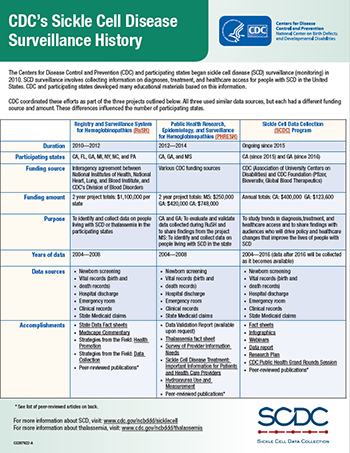Sickle Cell Disease Monitoring

CDC is working to improve the lives of people with sickle cell disease (SCD), an inherited blood disorder. Learn about CDC’s SCD monitoring projects, and find a suite of online resources that can help you or someone you know live healthy with SCD.
Sickle cell disease (SCD) is a blood disorder present at birth. People with SCD have “sickle” shaped red blood cells that stick together and block blood and oxygen from reaching all parts of the body, leading to health problems such as pain, anemia, infections, and stroke. Approximately 100,000 Americans are affected by SCD. CDC is committed to studying SCD to improve the health and care of people with this condition.
CDC Monitoring Projects
CDC, and participating states, began SCD surveillance (monitoring) in 2010 to learn more about people with SCD and the health problems they experience. SCD monitoring involves collecting information on diagnoses, treatments, and healthcare access for people with SCD in the United States.

Learn more about CDC’s SCD surveillance history through a fact sheet that allows you to compare each project using information about data sources, participating states, and accomplishments of each project.
CDC coordinated these efforts as part of three projects:
- Registry and Surveillance System for Hemoglobinopathies (RuSH) (from 2010-2012)
- Public Health Research, Epidemiology, and Surveillance for Hemoglobinopathies (PHRESH) (from 2012-2014)
- Sickle Cell Data Collection (SCDC) program (ongoing since 2015)
The SCDC program, which has been ongoing since 2015, is CDC’s current monitoring project. The SCDC program collects health information about people with SCD to study the long-term trends in diagnosis, treatment, and healthcare access for people with SCD in the United States. Currently, Georgia and California are the states participating in the SCDC program. As more resources become available, CDC plans to expand the program to include additional states. The program will help inform policy and healthcare standards to improve and extend the lives of people with SCD.
Learn more about the SCDC program:
- SCDC Program Report: Data to Action
- SCDC Program Fact Sheet
- Maps and Figures on SCDC Data by State – California and Georgia
- SCDC Publications
- SCDC Policy Memo: Understanding Sickle Cell Disease: CDC’s Role in Surveillance, Education, and Awareness
- The Bloodline Newsletter is a quarterly e-newsletter providing updates about the SCDC Program. Visit the webpage to subscribe.

Learn more about the Transfusion Complications Monitoring project.
The Transfusion Complications Monitoring project is a collaboration between CDC, Georgia State University, University of Florida, and the UCSF Benioff Children’s Hospital Oakland. Some people with SCD and thalassemia may require blood transfusions to stay healthy, but, sometimes, they may experience health problems after receiving blood transfusions. This project aims to learn more about transfusion-related health problems and to identify ways to decrease these health problems to improve the health of people with SCD, thalassemia, and other red blood cell disorders.
Find resources based on the Transfusion Complications Monitoring project:
- Educational videos on topics related to blood transfusions.
- Transfusion Complications Monitoring Publications.
- Provider and patient resources about blood transfusions and blood donations.
- Watch the Minority Blood Donation video to learn about the importance of African American blood donors to people with SCD.
Other Online Resources
For Patients and Caregivers
- SCD materials webpage has fact sheets and infographics on living well with SCD. SCD resources are also available in Spanish at our SCD Spanish webpage.
- Sickle Cell Trait Toolkit is a collection of fact sheets covering various health problems affecting people with sickle cell trait.
- Stepping Up: A 2-part video series for teenagers and young adults with SCD. The videos share the stories of Kevin and Calvanay, two young adults with SCD, and their transition to adult care, how it has affected them, and how they’ve overcome challenges. Spanish transcripts of the videos are available online.
- SCDC webinars, hosted by the SCDC program in California, are free and open to the public. Watch previous recordings or sign up to join the email list for announcements about upcoming webinars.
For Healthcare Providers:
- “Understanding the Complications of Sickle Cell Disease,” published in the American Journal of Nursing, provides an overview of major SCD-related health complications, as well as the nursing implications for each. CNE credits are available. Available as a free resource, download and print a table that lists the major SCD complications and their nursing implications.
- Provider Training Video Series: “Reducing Complications of Therapeutic Blood Transfusions in Sickle Cell Disease” is a 4-part educational video series for healthcare providers. Created in collaboration with the Georgia Health Policy Center, this training series is designed to provide information about and strategies for reducing transfusion complications in people with SCD. For CME/CNE credits, go to cdc.gov/TCEOnline, click search, and type in the course number and module title. The course number starts with a ‘WD’ and is followed by four numbers.
- In a CDC Expert Commentary on Medscape about transfusions in SCD, Dr. Mary Hulihan, a Health Scientist in the Division of Blood Disorders at CDC, discusses scenarios in which transfusions are appropriate for people with SCD, the complications associated with these transfusions, and how to lower the risk of complications from transfusions.
What You Can Do
Help spread the word! We encourage you to share our resources with friends, family, and colleagues to help people with SCD live healthy. Follow @CDC_NCBDDD on Twitter for future updates and to learn about new resources on SCD and other blood disorders. For more information about SCD, visit CDC’s SCD website.
